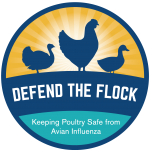Influenza is a virus that can infect humans and many animal species, including poultry and other birds. Influenza is not uncommon and it has been around for centuries. Influenza in poultry is not a food safety issue.
Influenza in poultry falls into two groups: low pathogenic avian influenza (LPAI), or highly pathogenic avian influenza (HPAI).
- Similar to influenza symptoms in people, birds infected with LPAI usually experience only mild signs if any, including respiratory signs such as conjunctivitis and nasal discharge, ruffled feathers or a drop in egg production.
- Unlike LPAI, the first indication of HPAI in poultry is sudden death, often without signs of illness. In the last 40 years, there have been introductions of LPAI in Minnesota poultry all of which have been successfully eliminated.
Theses are keys to detecting and preventing avian influenza in Minnesota:
- KNOW THE SIGNS. Any unexplained increase in mortality, decreased egg production, respiratory issues, quiet or depressed birds or neurologic (twisted necks) signs of disease should be investigated. Make sure the people who work with your birds daily (either you or your workers) know what to look for. If you find one or two dead birds in your flock for a couple days in a row, and cannot explain their death, contact your veterinarian, even if all other birds look fine.
- REPORT WHAT YOU’RE SEEING. Call your veterinarian to describe the signs in your flock. Call the Board at 320-231-5170 if you do not have a veterinarian.
- SUBMIT SAMPLES FOR TESTING. Samples for official avian influenza testing must be collected by an accredited veterinarian or individuals trained and certified as authorized poultry testing agents. The Minnesota Low Pathogenic Avian Influenza Response Plan requires 30 pooled tracheal swab samples from each barn when birds are showing signs of disease consistent with influenza. Always collect samples from dead birds before others. Every grower should calculate the number of tracheal swab supplies (BHI tubes and swabs) needed to sample flocks within your operation. Call the MPTL (320-231-5170) or email poultry@state.mn.us to get supplies at no cost! Samples should be submitted to the Minnesota Poultry Testing Laboratory (MPTL). When collecting samples in these situations, please call ahead to the MPTL to notify when samples will arrive.
- PREVENT EXPOSURE. Follow your biosecurity plan. Biosecurity can prevent avian influenza if you use it consistently. Pay special attention to the line of separation. Carefully follow safe entry and exit procedures into your flock. Spring weather can make these procedures difficult because of mud, rain, wind and other shifting weather conditions. At the same time, puddles and other standing water may attract waterfowl to get even closer to barns. This is the time to really focus on safe barn entries. Make sure garbage and dead birds are picked up outside of your perimeter buffer area. One of the most common ways HPAI moves around is through the movement of dead birds and garbage off the farm.
- IF YOU SEE SOMETHING, SAY SOMETHING. Remind everyone you talk to about their role in your farm’s biosecurity. Evaluate your risks, ask questions and participate in protecting your flocks.



